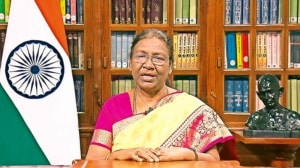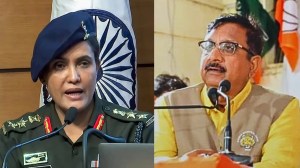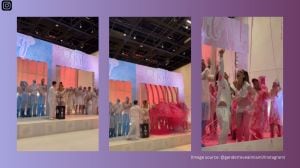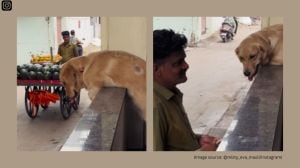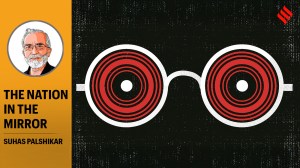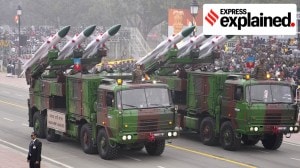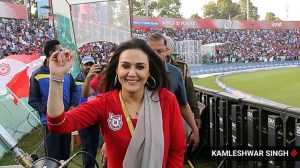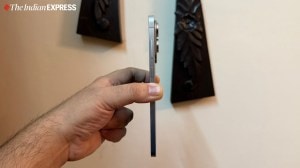UPSC Key: Online Gaming, Pricing mechanism of LPG and Asset Declaration by Judges
Why the 1997 Restatement of Values of Judicial Life is relevant to the UPSC exam? What is the significance of topics such as EU-US trade standoff, Reservation in private universities and special additional excise duty (SAED), on both the preliminary and main exams? You can learn more by reading the Indian Express UPSC Key for April 8, 2025.
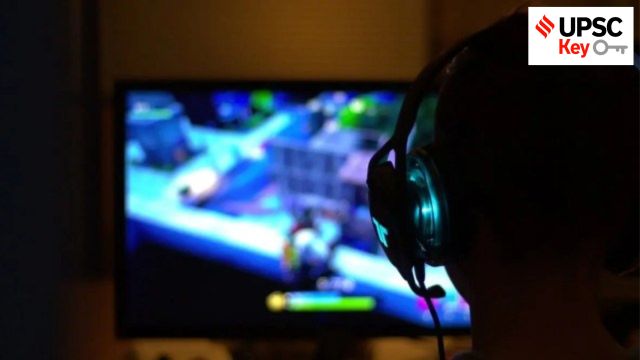 UPSC Key April 2025: Here's what you should be reading from the April 8, 2025 edition of The Indian Express
UPSC Key April 2025: Here's what you should be reading from the April 8, 2025 edition of The Indian Express Important topics and their relevance in UPSC CSE exam for April 8, 2025. If you missed the April 7, 2025 UPSC CSE exam key from the Indian Express, read it here
FRONT PAGE
Govt works to bring online gaming firms under PMLA fold
Syllabus:
Preliminary Examination: Current events of national and international importance
Mains Examination: General Studies II: Government policies and interventions for development in various sectors and issues arising out of their design and implementation.
What’s the ongoing story: The Centre is in advanced stages of finalising a move that could bring online real-money gaming companies such as Dream11, Games24x7, and Winzo under the ambit of anti-money laundering laws and subject them to stricter obligations such as know-your-customer (KYC) requirements, and tracking and reporting suspicious transactions, The Indian Express has learnt.
Key Points to Ponder:
• What is Online Gaming?
• Is it legal to play games and gamble online in India?
• What is real money gaming (RMG) industry? ?
• How big is the real money gaming market in India?
• Online gaming so far has been a state subject-true or false?
• How big is the online gaming market in India?
• Online Gaming Regulation in India—What laws and regulations says about the same?
• What is Prevention of Money Laundering Act (PMLA)?
• Online Gaming—What are the issues and concerns?
Key Takeaways:
• The proposal, steered by the Ministry of Finance and sent for inter-ministerial consultations, could result in online real-money gaming companies getting denoted as “reporting entities” under the Prevention of Money Laundering Act (PMLA), 2002.
• PMLA stipulates certain record-keeping and reporting obligations for financial institutions — banks, financial intermediaries or a
person carrying on a designated business or profession — by classifying them as reporting entities.
• A reporting entity, under PMLA, has to furnish information about its clients and transactions to Financial Intelligence Unit-India (FIU-IND) under the Ministry of Finance and follow a number of compliance obligations including maintaining a record of all transactions, documents evidencing identity of its clients and beneficial owners as well as account files and business correspondence relating to its clients.
• It is also subject to compliance with anti-money laundering and countering the financing of terrorism (AML/CFT) obligations, in line with norms of the global money laundering watchdog Financial Action Task Force (FATF).
• In a similar move in 2023, the Finance Ministry had notified virtual digital assets (VDAs) as reporting entities, a measure which was squarely aimed at cryptocurrency firms.
• If this is finalised, it would mark the second major action on gaming companies after a 28 per cent Goods and Service Tax (GST) was levied on full deposits that users make on such apps in 2023.
• It also follows rules to regulate the sector which were notified by the IT Ministry, but remain in limbo and unenforceable due to procedural issues.
Do You Know:
• According to a report by FICCI and EY from March 2025, online gaming companies in India collectively earned a revenue of close to $2.7 billion in 2024. These companies typically make money by taking a cut from a user’s winnings.
• As per the report, more than 155 million Indians engaged with real money gaming sub-segments such as fantasy sports, rummy, poker, and other transaction-based games in 2024, marking a 10 per cent increase over 2023. On an average, around 110 million people played these games daily.
• Sources in the gaming sector, who work for companies based in India, said that while domestic companies will abide by requirements of the PMLA, their concern is that offshore betting and gambling apps are unlikely to abide by the requirements — an issue they had raised when the 28 per cent GST was imposed on them.
• The government has been acting against flouting of compliance norms by online gaming companies. Earlier this month, the government informed Parliament that the IT Ministry had issued more than 1,400 blocking directions related to online betting/gambling/gaming websites between 2022- 2025 (until February). The Directorate General of GST Intelligence (DGGI) has blocked over 350 links of illegal and non-compliant offshore online money gaming platforms.
• Much of the industry’s woes also stem from the fact that the IT Ministry’s effort to regulate the online gaming sector, which was done through amendments to the Information Technology (IT) Rules, have failed to take off and have had no regulatory teeth.
• In April 2023, the ministry had notified rules for online gaming which allowed for the setting up of self-regulatory bodies to vet the legitimacy of online games, with oversight of the government, among other provisions.
• However, some proposals for self-regulation could not be accepted by the ministry as it felt they may be influenced by the gaming industry, raising potential conflict of interest issues.
• In an ongoing case in the Madras High Court where the court is hearing challenges to the state’s online gaming law, the IT Ministry, in a submission, said that the IT Rules provisions related to the sector remained “unenforceable” since the ministry has not designated any self- regulatory bodies.
Other Important Articles Covering the same topic:
📍Online gaming sector: What are the proposed rules to regulate it?
UPSC Previous Year Prelims Question Covering similar theme:
1. Which of the following is/are the aim/aims of “Digital India” Plan of the Government of India? (2018)
1. Formation of India’s own Internet companies like China did.
2. Establish a policy framework to encourage overseas multinational corporations that collect
3. Big Data to build their large data centres within our national geographical boundaries.
4. Connect many of our villages to the Internet and bring Wi-Fi to many of our schools, public places and major tourist centres.
Select the correct answer using the code given below:
(a) 1 and 2 only
(b) 3 only
(c) 2 and 3 only
(d) 1, 2 and 3
UPSC Previous Year Mains Question Covering similar theme:
📍Discuss how emerging technologies and globalisation contribute to money laundering. Elaborate measures to tackle the problem of money laundering both at national and international levels. (2021)
EXPRESS NETWORK
LPG to cost `50 more, CNG `1; no change in petrol, diesel retail rates
Syllabus:
Preliminary Examination: Economic and Social Development
Main Examination: General Studies III: Indian Economy and issues relating to planning, mobilization, of resources, growth, development and employment.
What’s the ongoing story: The government on April 7, 2025, hiked the excise duty on petrol and diesel by Rs 2 per litre and announced an increase in the price of cooking gas cylinders by Rs 50 with effect from April 8, 2025.
Key Points to Ponder:
• Pricing mechanism of LPG (Liquefied Petroleum Gas) in India—What you know about the same?
• Excise duty on petrol and diesel is a part of the Union government’s revenue—True or False?
• What is the special additional excise duty in India?
• How petrol diesel excise duty is calculated in India?
• What are the trade-offs involved in fuel tax policies in India?
• What are the possible implications of an increase in excise duty and cooking gas prices on the Indian economy?
• How excise duty hikes on petroleum products can impact on the fiscal health of oil marketing companies (OMCs)?
• How subsidy rationalisation and price reforms ensures the financial sustainability of the LPG distribution system in India?
• What are the issues and challenges in achieving a fair price mechanism in Petroleum pricing that safeguards both consumer interest and corporate viability?
Key Takeaways:
• Both these steps, according to Petroleum Minister Hardeep Singh Puri, are aimed at providing relief to public sector oil marketing companies (OMCs) by compensating them for their accumulated losses on cooking gas sales.
• To insulate consumers from high prices of liquefied petroleum gas (LPG, or cooking gas) in the international market, the OMCs have been selling LPG to households at a loss.
• The hike in fuel excise duty was notified by the Finance Ministry on Monday afternoon. Speaking to reporters shortly after, Puri clarified that the burden of increased excise duty will not be passed on to the consumers and it will have no impact on retail prices of the two fuels.
• The minister indicated that the additional amount collected as a result of the duty hike may eventually be used by the government to cover the OMCs’ losses on LPG sales. He said that the OMCs will also hike LPG prices for households by Rs 50 from Tuesday morning, which will also help in reducing their under-recoveries on cooking gas sales.
• Amid a steep fall in international crude oil prices over the mounting trade friction between the US and China, the government hiked the Special Additional Excise Duty (SAED) on petrol to Rs 13 per litre from Rs 11, and that on diesel to Rs 10 from Rs 8 per litre.
• SAED is a component in the overall fuel excise structure and goes entirely into the Centre’s kitty, unlike the Basic Excise Duty (BED) that is shared with states. Over the past 11 years, the government has hiked excise duty on petrol and diesel on a number of occasions when international oil prices saw significant downward correction. It has also cut excise duty on the two fuels on a few occasions to provide relief to consumers when global oil prices rose notably.
• As for domestic cooking gas prices, a 14.2-kg cylinder will cost Rs 853 from Tuesday for general households, up from Rs 803 in Delhi, with corresponding changes in other states. For poor households availing cooking gas under the Ujjwala scheme, the price in Delhi will go up to Rs 553 per cylinder from Rs 503. As India depends on imports to meet its LPG demand, cooking gas prices are linked to international LPG price benchmarks.
Do You Know:
• Annual petrol and diesel sales in the country stand at around 16,000 crore litres, which means that the increase in excise duty should lead to an additional revenue of around Rs 32,000 crore for the government on an annualised basis.
• The Petroleum Ministry and the OMCs expect this incremental revenue to flow back into the OMCs as government support. Notably, in October 2022, the government had approved a one-time grant of Rs 22,000 crore for OMCs to partially cover their accumulated losses of around Rs 28,000 crore at the time from selling LPG at a loss in consumer interest.
• According to industry insiders, the recent decline in international crude oil and petroleum product prices had created enough headroom for the Centre to increase the levy on the two fuels. Alternatively, the benefit could have been passed on to the consumers in the form of a reduction in retail prices of the two fuels.
• According to the Petroleum Ministry’s estimates, the average Saudi CP—the international benchmark for LPG pricing—has gone up 63 per cent to $629 per tonne in February 2025 from $385 in July 2023. This should ideally translate into cooking gas being retailed at Rs 1,028.50 per 14.2-kg cylinder in Delhi. However, the OMCs have been selling cooking gas to households at a significant loss in consumer interest. The Petroleum Minister indicated that cooking gas prices will be reviewed every 15 days to a month and if international prices cool down, the benefit will be passed on to the consumers.
Other Important Articles Covering the same topic:
📍Explained: How fuel price decontrol works — or why consumers always lose out
UPSC Previous Year Prelims Question Covering similar theme:
2. In the context of global oil prices, “Brent crude oil” is frequently referred to in the news. What does this term imply? (2011)
1. It is a major classification of crude oil.
2. It is sourced from North Sea.
3. It does not contain sulphur.
Which of the statements given above is/are correct?
(a) 2 only
(b) 1 and 2 only
(c) 1 and 3 only
(d) 1, 2 and 3
THE IDEAS PAGE
Syllabus:
Preliminary Examination: Economic and Social Development
Main Examination: General Studies I: Social empowerment,
What’s the ongoing story: Yogendra Yadav writes: Reservation in private universities and colleges is an idea whose time had come long ago. If there was any doubt about its legality, that dispute too was resolved by the Supreme Court more than a decade ago.
Key Points to Ponder:
• Do you think reservation should be extended to private universities in India?
• What can be the legal, ethical, and practical dimensions reservation in private universities?
• What does the 93rd Constitutional Amendment Act deal with?
• Discuss the implications of 93rd Constitutional Amendment Act on equity and excellence in higher education.
• “Access to education cannot be left entirely to market forces.”—Discuss
• What is the role of the State in regulating private universities to ensure social equity?
• What are the issues and challenges in implementing affirmative action in the private education sector in India?
Key Takeaways:
Yogendra Yadav writes:
• It is an idea that enjoys the backing of the largest opposition party. True, in the last instance, you cannot stop an idea whose time has come. The trouble is that we live our lives in the instances before the last one, the intermediate space in which the deep state can delay, defer and dodge any idea. This idea needs political will. Now.
• The case for extending reservation to private higher educational institutions (or PHEI, which include “state private universities” and private “deemed universities”, besides aided and unaided private colleges) is straightforward.
• Higher education is a powerful mechanism for what scholars call “effectively maintained inequality”. Just as historically excluded communities are entering colleges and universities, the institutions they can access are being evacuated of educational quality and employment opportunities.
• The “happening site” — the upper end of higher education — is being effectively privatised into a space controlled by the upper-class and upper-caste elite. If we are to retain even a modicum of commitment to the constitutional guarantee of equality of opportunity, the state must step into this domain by extending the existing policy of reservation for SCs, STs and OBCs to private colleges and universities.
• We are witnessing two large-scale and long-term movements in the education sector. First, there is an unprecedented surge, a historic wave, in seeking higher education, mainly driven by the belated entry of communities that were historically denied learning. Satish Deshpande summarised this trend: “Between 1990–1991 and 2018–2019, the number of universities has increased almost five-and-a-half times and total enrolment has shot up by seven-and-a-half times, while the Gross Enrolment Ratio (GER) has gone up by two-and-a-half times.” The rate of growth is higher for all the marginal social groups — SC, ST, OBC and Muslims — and for women within each of these groups.
• That should have been good news but for the second phenomenon: The elite exodus from and the collapse of public higher education.
Do You Know:
Yogendra Yadav writes:
• In 2005, the 93rd Amendment to the Constitution introduced Article 15(5) that allowed the state to make “any special provision” for the advancement of SCs, STs or SEBCs (the legal name for OBCs) which relates to “admission to educational institutions including private educational institutions, whether aided or unaided by the state, other than the minority educational institutions”.
• The enabling provision was used by Parliament to pass the Central Educational Institutions (Reservation in Admission) Act, 2006 to
provide for reservation for OBCs, but only in central educational institutions.
• The Supreme Court (Ashok Kumar Thakur vs Union of India, 2008) upheld this reservation for state-run and state-aided institutions, keeping the issue of unaided private institutions open. This remaining issue was also resolved, first by a two-judge bench (IMA vs Union of India, 2011) and then a five-judge bench (Pramati Educational and Cultural Trust vs Union of India, 2014) that upheld reservation in unaided private institutions. So, there is no legal hitch any more.
• The profile of the private HEIs needs no guessing. They do not follow any reservation, except of course the unstated reservation for the rich. The latest All India Survey of Higher Education data for 2021-22 shows that upper-caste Hindus (around 20 per cent of the country’s population) are well over 60 per cent of private university students. Here is the social group-wise breakdown of students in private (state private and deemed private) universities: SCs were just 6.8 per cent (current population share about 17 per cent), STs 3.6 per cent (population around 9 per cent), OBCs 24.9 per cent (population between 45-50 per cent) and Muslims 3.8 per cent (population around 15 per cent). Needless to say, the picture would be even more skewed in the case of elite private universities and the sought-after courses in these institutions.
• Reservation can make a difference. If we compare the social profile of students in public sector universities that are required to follow reservation, the difference is obvious: 14.6 per cent SCs, 6 per cent STs, and 31.2 per cent for OBCs. There is little difference in the case of Muslims (4.1 per cent) who do not enjoy reservation. For all its limitations, quota-based affirmative action works.
Other Important Articles Covering the same topic:
📍Wary of 10% quota, private institutions await clarity on fees
UPSC Previous Year Prelims Question Covering similar theme:
3. Consider the following statements:
Statement-I: The Supreme Court of India has held in some judgments that the reservation policies made under Article 16(4) of the Constitution of India would be limited by Article 335 for maintenance of efficiency of administration.
Statement-II: Article 335 of the Constitution of India defines the term ‘efficiency of administration’.
Which one of the following is correct in respect of the above statements?
(a) Both Statement-I and Statement-II are correct and Statement-II is the correct explanation for Statement-I
(b) Both Statement-I and Statement-II are correct and Statement-II is not the correct explanation for Statement-1
(c) Statement-I is correct but Statement-II is incorrect
(d) Statement-I is incorrect but Statement-II is correct
ECONOMY
Textile major Bangladesh offers US cotton purchase to dodge tariff
Syllabus:
Preliminary Examination: Current events of national and international importance.
Main Examination: General Studies II: Effect of policies and politics of developed and developing countries on India’s interests
What’s the ongoing story: Bangladesh, the world’s second-largest ready-made garment exporter after China, on Monday offered to purchase various US farm products, including cotton, duty-free in an effort to avoid reciprocal US tariffs, a letter from Bangladesh’s Chief Adviser, Muhammad Yunus, to US President Donald Trump showed.
Key Points to Ponder:
• Know the role of Bangladesh in the global textile supply chain.
• What factors led to the Bangladesh as a global textile leader despite limited raw material production?
• The textile industry and global trade relations—Connect the dots
• How do tariff threats influence the sourcing and export strategies of textile-exporting countries?
• How developing economies like Bangladesh manage big power pressures through trade diplomacy?
• “Reciprocal tariffs can act both as barriers and bargaining tools in international trade.”—Discuss
• The Textile industry in India-Know in detail
• What are the key challenges faced by Textile industry in India?
• Despite being a global leader in fibre production, India’s textile industry lags behind in growth and exports—Discuss
• Discuss the role of government policies such as PLI, SITP, and ATUFS in revitalizing the Textile sector.
• How does India’s textile sector compare with that of China and Bangladesh in terms of production, export competitiveness, and infrastructure?
Key Takeaways:
• Yunus sought a three-month postponement of the reciprocal tariff measure on Bangladeshi exports to the US, proposing a series of initiatives, including facilitating the launch of Billionaire Elon Musk’s Starlink in Bangladesh and opening the country’s advanced tech sectors—such as civil aviation and defence—to US companies. Several textile manufacturing hubs such as Vietnam, Cambodia have also sought such deals with the US.
• The move comes amid concerns that reciprocal tariffs have disproportionately affected smaller, more vulnerable economies due to the nature of US tariff calculations. Bangladesh has been hit with a 37 per cent reciprocal tariff, a big blow to its textile sector — the country’s largest foreign exchange earner.
• India, which exports over $2 billion worth of cotton and yarn to Bangladesh annually, has a stake in the Bangladesh textile industry as several Indian textile firms operate factories in Bangladesh to benefit from the favourable duty regime granted to nations bracketed as Least Developed Countries (LDCs) by the European Union.
Do You Know:
• Bangladesh is currently recovering from a political and economic crisis in the country last year. High inflation had eroded Dhaka’s US dollar reserves, limiting the country’s ability to import critical goods such as agricultural items, iron and steel, electricity, and plastics from India. During the last financial year, economic activity has been slowing in Bangladesh as its imports of petroleum products from India slipped 8 per cent in June compared to May last year.
• After China, India is the second largest producer of cotton, accounting for 24% of global production. Cotton cultivation engages around 60 lakh farmers, mostly across Gujarat, Maharashtra, and Telangana. The entire cotton textile value chain—from processing raw fibre and spinning yarn to weaving fabric, dyeing, and stitching—employs over 4.5 crore people.
• The size of India’s textile and apparel industry cannot be understated—it contributes 13% to industrial production, 12% to exports, and roughly 2% to GDP. However, manufacturing in the textile and apparel industry has slightly contracted over the past 10 years, according to the Index of Industrial Production (IIP).
Other Important Articles Covering the same topic:
📍What’s ailing India’s textile industry and govt’s attempts to improve competitiveness
Previous Year Prelims Question Covering similar theme:
4. Consider the following statements: (2020)
1. The value of Indo-Sri Lanka trade has consistently increased in the last decade.
2. “Textile and textile articles” constitute an important item of trade between India and Bangladesh.
3. In the last five years, Nepal has been the largest trading partner of India in South Asia.
Which of the statements given above is/are correct?
(a) 1 and 2 only
(b) 2 only
(c) 3 only
(d) 1, 2 and 3
UPSC Previous Year Mains Question Covering similar theme:
📍Analyse the factors for highly decentralized cotton textile industry in India. (2013)
THE WORLD
Europe to prioritise talks to remove Trump tariffs, readies 1st response
Syllabus:
Preliminary Examination: Current events of national and international importance.
Main Examination: General Studies II: Effect of policies and politics of developed and developing countries on India’s interests
What’s the ongoing story: The European Commission said on Monday it had offered a “zero-for-zero” tariff deal to avert a trade war with U.S. President Donald Trump as EU ministers agreed to prioritise negotiations, while striking back with 25% tariffs on some U.S. imports.
Key Points to Ponder:
• EU-US trade standoff—What is the current situation?
• “Retaliatory tariffs, while lawful under WTO rules, often undermine global trade stability”—Discuss
• Know the impact of rising protectionism on multilateral trade institutions such as the WTO.
• What role can emerging economies like India play in preserving a rules-based trade order?
• How effective would be an economic diplomacy in resolving trade conflicts between developed economies?
• How do tariff wars between major global economies affect developing countries like India?
Key Takeaways:
• The 27-nation bloc faces 25% import tariffs on steel and aluminium and cars and broader tariffs of 20% from Wednesday for almost all other goods under Trump’s policy to hit countries he says impose high barriers to U.S. imports.
• On Monday evening, the Commission proposed its first retaliatory tariffs at 25% on a range of U.S. imports in response to Trump’s steel and aluminium tariffs rather than the broader levies.
• However, the list was shortened after the EU executive bowed to pressure from member states and removed bourbon, wine and dairy after Trump threatened a 200% counter-tariff on EU alcoholic drinks. France and Italy, major exporters of wine and spirits, were particularly concerned.
EU trade chief Maros Sefcovic said earlier on Monday the retaliation would impact less than the previously announced 26 billion euros ($28.4 billion). The tariffs for most of the goods will go into effect May 16 and some from December 1.
• Ministers overseeing trade met in Luxembourg on Monday to debate the EU’s response and discuss relations with China. Many said the priority was to launch negotiations to remove Trump’s tariffs, rather than fight them.
Michal Baranowski, deputy economy minister of Poland, told a press conference after the meeting that his EU counterparts did not want to be “trigger-happy”.
Do You Know:
• The EU is set to approve the first retaliatory measures this week. The bloc will start collecting the tariffs on April 15, with a second tranche starting a month later.
• The removal of bourbon from the list of items subject to the EU’s retaliatory tariffs on U.S. imports “would be great news, and we are hopeful this is the case,” said Chris Swonger, chief executive of the Distilled Spirits Council of the United States. “It would be the first step toward getting the U.S.-EU spirits sectors back to zero-for-zero tariffs and untangling distilled spirits products from these wider trade disputes.”
• The bloc is expected to produce a larger package of countermeasures by the end of April, as a response to U.S. car and broader tariffs.
• In a war of tariffs on goods, Brussels has less to target than Washington, given EU goods imports from the U.S. totalled 334 billion euros ($366.2 billion) in 2024, against 532 billion euros of EU exports to the U.S.
Some EU countries, particularly those exposed to trade with the United States, urged caution. Irish Foreign Minister Simon Harris described the Anti-Coercion Instrument as “very much the nuclear option.”
Other Important Articles Covering the same topic:
📍‘Sometimes you have to take medicine’: Trump on US tariffs move as global markets reel
EXPLAINED
The 1997 ethics code which mentioned idea of SC judges declaring assets
Syllabus:
Preliminary Examination: Indian Polity and Governance-Constitution, Political System, Panchayati Raj, Public Policy, Rights Issues, etc.
Main Examination: General Studies II: Important aspects of governance, transparency and accountability
What’s the ongoing story: Following a significant decision taken during a full court meeting on April 1, all judges of the Supreme Court, including the Chief Justice of India, will publicly declare their assets. It comes on the heels of the discovery of wads of currency notes at the residence of Delhi High Court judge Yashwant Varma last month.
Key Points to Ponder:
• What is the significance of the 1997 Restatement of Values of Judicial Life?
• What has been the position of the Supreme Court in this matter so far?
• Are public servants such as elected representatives and government officials required to put their assets and liabilities in the public domain?
• What are the essential facts about asset declaration by judges?
• What are the norms and regulations regarding the declaration of assets by judges?
• What is the necessity for judges to declare their assets?
• Do other nations possess conventions and legislation regarding Judges’ Asset Declarations?
Key Takeaways:
• Unlike government officials and politicians, judges are not bound to make this information public, and most have not done so. The recent decision could mark an important shift and is essentially a reiteration of the 1997 Restatement of Values of Judicial Life, a code of ethics that the judiciary adopted in another full court meeting.
• Through the code, the SC attempted to create a framework for institutional accountability on multiple issues. It included declarations of judges’ assets and investments to the CJI and laying the groundwork for an “in-house procedure” to conduct inquiries against judges who allegedly transgressed these “values” and faced allegations of misbehaviour or corruption.
• Adopting the “Restatement of Values of Judicial Life” gave ground to for every future measure for ensuring judicial accountability. It is a numbered, non-exhaustive list of 16 entries enumerating values for judges to uphold and pitfalls for them to avoid. which can be summarised as:
—Judges must avoid actions that “erode” people’s faith in the higher judiciary, as “Justice must not merely be done but it must also be seen to be done”;
—Must not contest elections/hold office in clubs, societies, and associations;
—Must avoid close association with “individual members of the Bar” and if any immediate or close family members are members of the Bar, they must not appear before the judge in court or be associated with any case or “cause” she is dealing with;
—Similarly, such family members cannot be permitted to use the judge’s residence for professional work;
—Must practice “a degree of aloofness consistent with the dignity of his office”, i.e. being impartial by maintaining distance from the case before her;
—Must not hear and decide cases where a family member or friend is involved;
—Must not publicly express views on political matters that may arise for judicial determination;
—Must “let his judgments speak for themselves” and must not give interviews to the media;
—Must not accept gifts or hospitality from anyone besides family and friends;
—Must not hear and decide matters involving a company in which the judge holds shares unless previously disclosed and no objection is raised;
—Must not “speculate in shares, stocks or the like”;
—Must not engage in any trade or business “directly or indirectly”. This does not include legal publishing or anything “in the nature of a hobby”;
—Should not seek any financial benefit connected to her office “unless it is clearly available”;
—Must be conscious that she is “under the public gaze” and avoid acts “unbecoming of the high office”.
Do You Know:
• Back in 1997, at a meeting chaired by then Chief Justice of India, the late Justice J S Verma, the Supreme Court adopted a resolution that judges would declare their assets to the Chief Justice.
The resolution said: “Every judge should make a declaration of all assets in the form of real estate or investment held in their names, in the name of their spouses or any other person dependent on them, to the Chief Justice.” This was not a call for public disclosure of the assets of judges — only a disclosure to the Chief Justice.
• More than a decade later, in a meeting held on September 8, 2009, the full Bench of the Supreme Court resolved to declare the assets of judges on the court’s website, but added that this was being done “purely on a voluntary basis”. These declarations appeared on the SC website in November that year, after which a few High Courts followed suit.
However, the SC website has not been updated since 2018. No declarations submitted by the current judges are available. The website only gives a list of 28 judges of the court (out of a total 33) “who have submitted their declarations of assets” to the CJI.
• Declarations by former judges have also been removed from the website.
• This situation exists despite the fact that the apex court had itself held in 2019 that the assets and liabilities of judges are not “personal information”.
This was in a case that began in January 2009 when Right to Information (RTI) activist Subhash Chandra Agarwal filed an application under the RTI Act to determine whether SC judges had indeed declared their assets to the CJI, as had been resolved in 1997.
• As of March 1 this year, there were 770 judges in all High Courts put together. Only 97 of these judges — belonging to seven High Courts, viz., Delhi, Punjab & Haryana, Himachal Pradesh, Madras, Chhattisgarh, Kerala, and Karnataka — have publicly declared their assets and liabilities. These judges make up fewer than 13% of all High Court judges.
• Most High Courts in the country have been against the public disclosure of their judges’ assets and liabilities.
• In 2012, the Uttarakhand High Court passed a resolution stating that it “strongly objects to bring disclosure of assets by Judges under the purview of Right to Information Act”.
Other Important Articles Covering the same topic:
Previous year UPSC Prelims Question Covering similar theme:
5. With reference to the Constitution of India, consider the following statements: (2019)
1. No High Court shall have the jurisdiction to declare any central law to be constitutionally invalid.
2. An amendment to the Constitution of India cannot be called into question by the Supreme Court of India.
Which of the statements given above is/are correct?
(a) 1 only
(b) 2 only
(c) Both 1 and 2
(d) Neither 1 nor 2
Previous year UPSC mains Question Covering similar theme:
📍Judicial Legislation is antithetical to the doctrine of separation of powers as envisaged in the Indian Constitution. In this context justify the filing of large number of public interest petitions praying for issuing guidelines to executive authorities. (2020)
|
PRELIMS ANSWER KEY |
|
1. (b) 2.(b) 3.(c) 4.(b) 5.(d) |
For any queries and feedback, contact priya.shukla@indianexpress.com
Subscribe to our UPSC newsletter. Stay updated with the latest UPSC articles by joining our Telegram channel – IndianExpress UPSC Hub, and follow us on Instagram and X.
Must Read
Buzzing Now



May 15: Latest News
- 01
- 02
- 03
- 04
- 05




